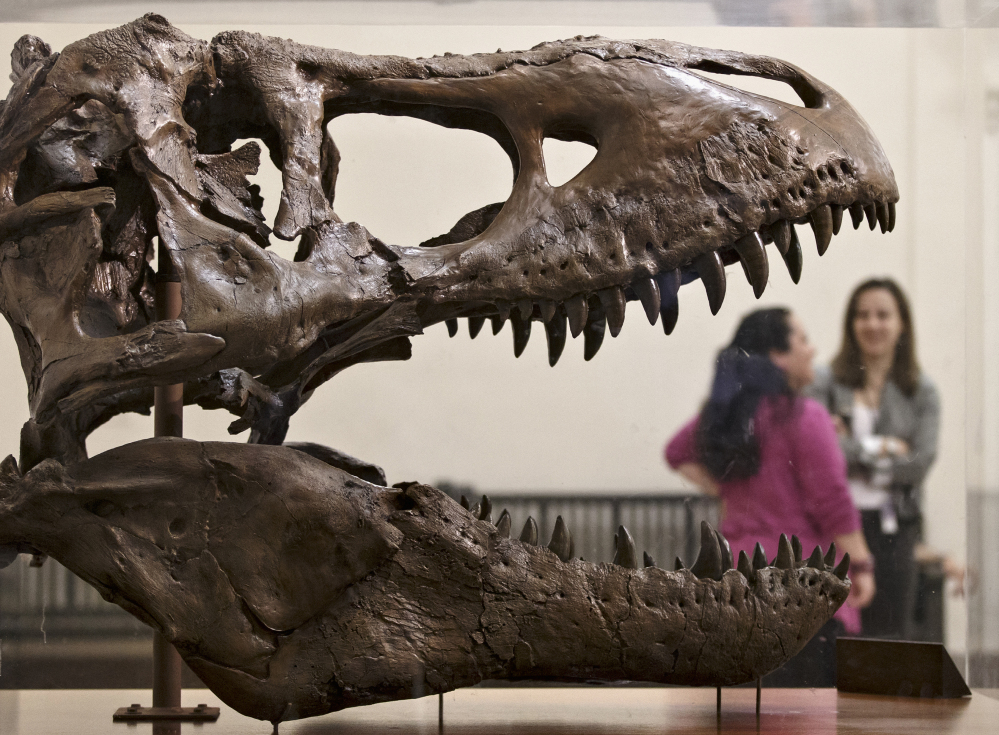The FedEx truck arrived before daybreak Tuesday, backing up to the loading dock at the Smithsonian’s National Museum of Natural History.
The police escort – which rolled with the semi from Hagerstown, Md., more than an hour from the Washington Mall – indicated a very special delivery. So, too, did the custom wrap on the trailer. “Delivering history: The Nation’s T. rex,” it said next to a painted Tyrannosaurus rex.
The first of 16 wooden crates – each sealed with tape and marked “FRAGILE” multiple times – rolled off the 53-foot-long trailer at 6:26 a.m. A few minutes later, museum director Kirk Johnson signed for the delivery of a dinosaur. Within a half-hour, all of the bone-filled boxes were being inspected inside the museum, which had finally filled the T. rex-sized hole in its fossil collection.
“It’s like Christmas morning,” declared dinosaur curator Matt Carrano.
The Nation’s T. rex, discovered by a Montana rancher near Fort Peck Reservoir in 1988 and owned by the Army Corps of Engineers, is on loan to the Natural History Museum for 50 years.
It will replace a life-size T. rex replica that’s been displayed in the Natural History Museum’s dinosaur hall since 1999, shortly after the Smithsonian lost out on Sue, the world’s most famous dinosaur fossil, at a hotly contested auction.
“The absence of a T. rex was unforgivable,” Johnson said, standing among the crates. “It’s this amazing dream for me to get this iconic fossil.”
“It’s a wonderful day for the nation,” said Lt. Gen. Thomas Bostick, the Army Corps commander who signed off on the long-term loan.
The world’s second-most-visited museum has big plans for the borrowed king carnivore: It will stand as the centerpiece of the new dinosaur hall that’s scheduled to open in 2019, after a five-year, $48 million makeover. The hall – one of the most visited spaces at the Natural History Museum – closes April 28.
“It’s an amazing object,” Johnson said of the T. rex.
The 38-foot-long dinosaur died more than 66 million years ago in a riverbed and was frozen in time – and rock – for eons. It remained unseen and undisturbed from the late Cretaceous Period until around Labor Day in 1988, when rancher Kathy Wankel spotted a small part of an arm bone during a day hike in a wildlife refuge.
Wankel and her husband, Tom, eventually brought their find to the Museum of the Rockies in Bozeman, Mont., where the chief “preparator of paleontology,” Patrick Leiggi, began furiously puffing his Marlboro Light upon seeing the prehistoric find.
Eventually, an excavation team unearthed between 80 and 85 percent of the bones on the Army Corps site, making it one of the five most complete T. rex specimens ever recovered. It included the first T. rex arm ever discovered (“not much bigger than my arm,” Johnson noted), and it was dubbed “the Wankel T. rex” by the Museum of the Rockies.
Kathy and Tom Wankel and 24 of their relatives were on hand for Tuesday’s occasion. “We’re very proud … parents,” Kathy Wankel said. “Big, ugly baby. But we think he’s beautiful.”
Send questions/comments to the editors.



Success. Please wait for the page to reload. If the page does not reload within 5 seconds, please refresh the page.
Enter your email and password to access comments.
Hi, to comment on stories you must . This profile is in addition to your subscription and website login.
Already have a commenting profile? .
Invalid username/password.
Please check your email to confirm and complete your registration.
Only subscribers are eligible to post comments. Please subscribe or login first for digital access. Here’s why.
Use the form below to reset your password. When you've submitted your account email, we will send an email with a reset code.